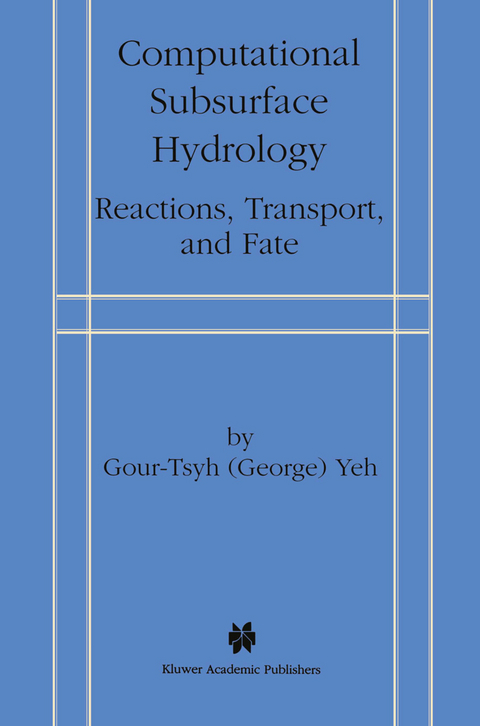
Computational Subsurface Hydrology
Springer-Verlag New York Inc.
978-1-4613-6965-3 (ISBN)
The fundamental processes occurring in subsurface media are rigorously integrated into governing equations using the Reynolds transport theorem and interactions of these processes with the surrounding media are sophisticatedly cast into various types of boundary conditions using physical reasoning. A variety of numerical methods to deal with reactive chemical transport are covered in Computational Subsurface Hydrology: Reactions, Transport, and Fate with a particular emphasis on the adaptive local grid refinement and peak capture using the Lagrangian-Eulerian approach. The topics on coupled fluid flows and reactive chemical transport are unique contributions of this book. They serve as a reference for research as well as for practical applications with a computer code that can be purchased from the author.
Four computer codes to simulate vertically integrated horizontal solute transport (LEMA), contaminant transport in moving phreatic aquifers in three dimensions (3DLEMA), solute transport in variably saturated flows in two dimensions (LEWASTE), and solute transport under variably saturated flows in three dimensions (3DLEWASTE) are covered. These four computer codes are designed for generic applications to both research and practical problems. They could be used to simulate most of the practical, real-world field problems.
Reactive chemical transport and its coupling with fluid flows are unique features in this book. Theories, numerical implementations, and example problems of coupled reactive transport and flows in variably saturated media are presented. A generic computer code, HYDROGEOCHEM 3.0, is developed. A total of eight example problems are used to illustrate the application of the computational model. These problems are intended to serve as examples for setting up a variety of simulations that one may encounter in research and field-site applications.
Computational Subsurface Hydrology: Reactions, Transport, and Fate offers practicing engineers and scientists a theoretical background, numerical methods, and computer codes for modeling contaminant transport in subsurface media. It also serves as a textbook for senior and graduate course on reactive chemical transport in subsurface media in disciplines such as civil and environmental engineering, agricultural engineering, geosciences, soil sciences, and chemical engineering.
Computational Subsurface Hydrology: Reactions, Transport, and Fate presents a systematic derivation of governing equations and boundary conditions of subsurface contaminant transport as well as reaction-based geochemical and biochemical processes. It discusses a variety of numerical methods for moving sharp-front problems, expounds detail procedures of constructing Lagrangian-Eulerian finite element methods, and describes precise implementation of computer codes as they are applied to subsurface contaminant transport and biogeochemical reactions.
1 Fundamental of the Subsurface System.- 1.1. Study of the Subsurface System.- 1.2. The Fundamental Concept of Continuum.- 1.3. Basis of Conceptual Mathematical Models.- 1.4. References.- 2 Reactive Geochemical and Biochemical Transport.- 2.1. Preliminary to Geochemical Equilibrium Systems.- 2.2. General Geochemical Equilibrium Systems.- 2.3. Geochemical Kinetic Systems.- 2.4. Mixed Geochemical Kinetic and Equilibrium Systems.- 2.5. Mathematical Formulation of Solute Transport.- 2.6. Microbe Transport and Fate.- 2.7. Generalized Reactive Transport in Variably Saturated Media.- 2.8. Mathematical Strategies for Reactive Transport.- 2.9. References.- 3 Numerical Methods for Advection-Dominant Transport.- 3.1. Introduction.- 3.2. Eulerian Approaches.- 3.3. Lagrangian Approaches.- 3.4. Lagrangian-Eulerian Approaches.- 3.5. References.- 4 Finite-Element Modeling of One-Component Solute Transport.- 4.1. Mathematical Models of Solute Transport Under Variably Saturated Flows.- 4.2. Finite-Element Modeling of Solute Transport in Variably Saturated Media.- 4.3. Mathematical Models of Solute Transport Under Saturated Flows.- 4.4. Finite-Element Modeling of Solute Transport in Saturated Media.- 4.5. Derivation of Vertically Integrated Transport Equations.- 4.6. Finite-Element Modeling of Solute Transport in Aquifers.- 4.7. References.- 5 Coupled Fluid Flow and Reactive Chemical Transport.- 5.1. Introduction.- 5.2. Mathematical Model.- 5.3. Numerical Solutions.- 5.4. Example Problems.- 5.5. References.
| Zusatzinfo | XXIII, 318 p. |
|---|---|
| Verlagsort | New York, NY |
| Sprache | englisch |
| Maße | 155 x 235 mm |
| Themenwelt | Naturwissenschaften ► Biologie ► Ökologie / Naturschutz |
| Naturwissenschaften ► Geowissenschaften ► Geologie | |
| Naturwissenschaften ► Geowissenschaften ► Hydrologie / Ozeanografie | |
| Naturwissenschaften ► Physik / Astronomie | |
| Technik ► Umwelttechnik / Biotechnologie | |
| Weitere Fachgebiete ► Land- / Forstwirtschaft / Fischerei | |
| ISBN-10 | 1-4613-6965-7 / 1461369657 |
| ISBN-13 | 978-1-4613-6965-3 / 9781461369653 |
| Zustand | Neuware |
| Haben Sie eine Frage zum Produkt? |
aus dem Bereich


